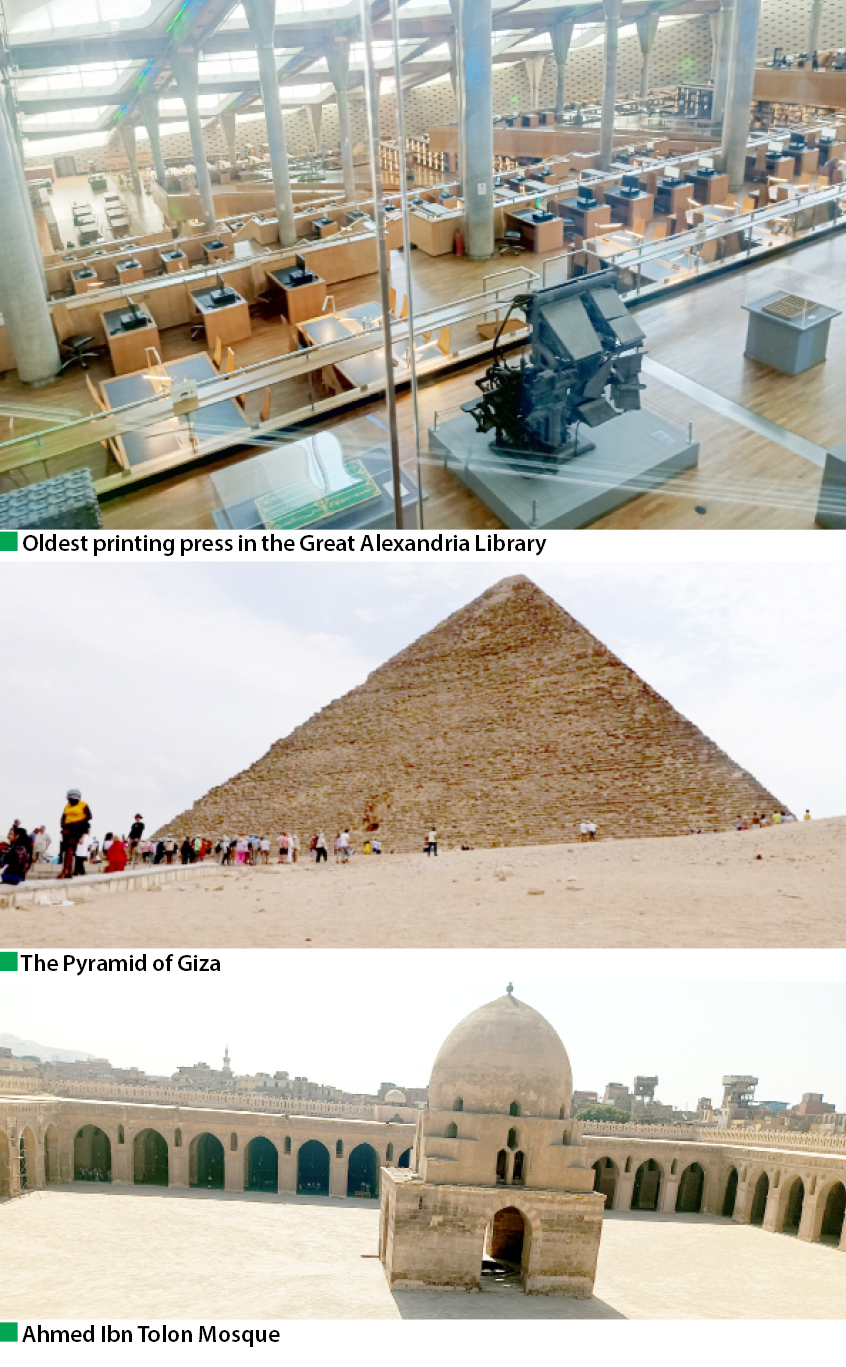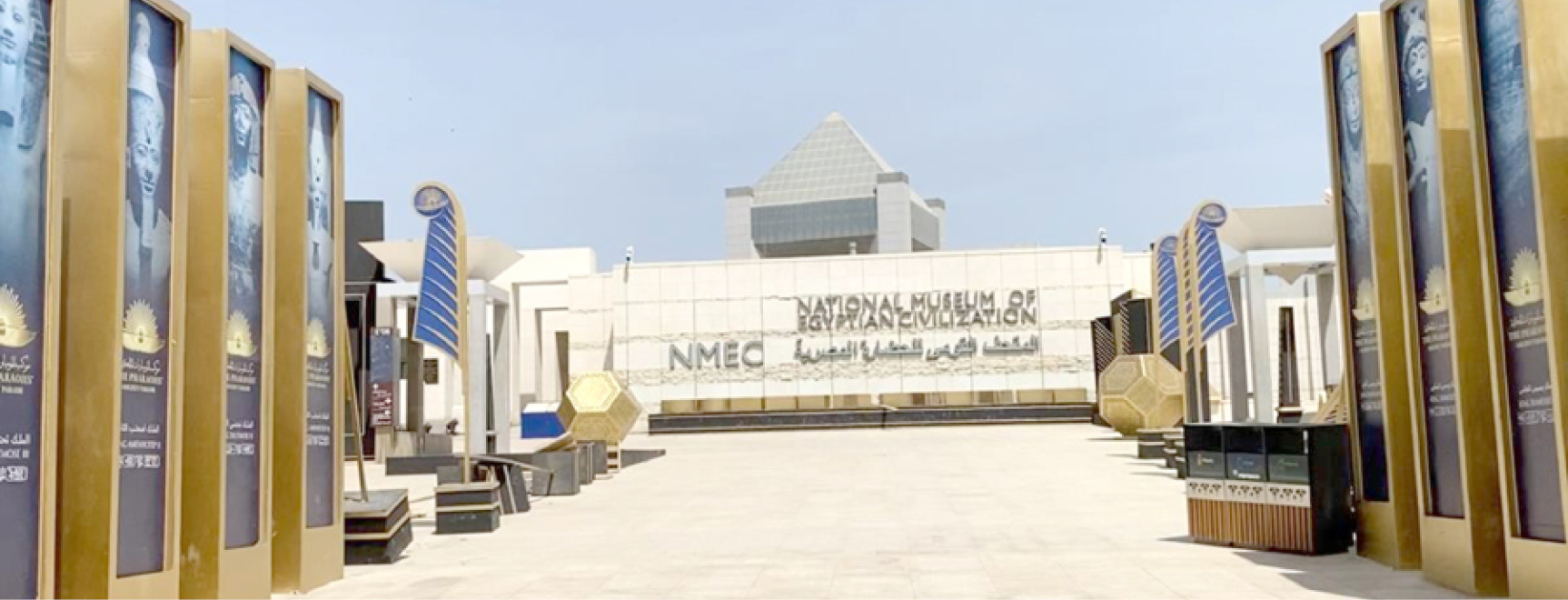Located in North Africa, Egypt is considered as one of the ancient countries of the world considering its historical monuments and archaeological bearings such as the pyramids of Giza, the museum of civilization, citadel of Qaitbay among others. Officially known as the Arab Republic of Egypt, the country serves as a linkage between North Africa and the Middle east. Philip Shimnom Clement highlights his experiences during the visit to these historic monuments and learning institutions as part of activities for the 57th Cohort Training for young African journalists, organised by the Supreme Council for Media Regulation and the Union of African Journalists.
The 57th training session for young African journalists which held in Cairo, Egypt, from September 16 to October 5, 2023 provided an opportunity for learning and relaxation for 20 young journalists from 14 countries of the African continent.
Participating countries in this year’s edition of the training include Nigeria, Cameroon, Kenya, Ghana, Togo, Congo Brazzaville and Burkina Faso.
Others are Zimbabwe, Zambia, Senegal, Cote d’Ivoire, Morocco, Tunisia and the host country Egypt.
The three weeks annual training organised by the Union of African Journalists and the Supreme Council for Media Regulations in Egypt exposed journalists to investigative and data journalism and also broadened their knowledge on critical issues on the continent.
I Pray Allah Not To Give Me What Would Not Benefit Others – Alhaji Aminu Dantata
Open letter to Borno State governor
At the opening ceremony, the Secretary General of the Union of African Journalists (UAJ) Dr Samia Abbas, noted that “For the 57th training session, the programme will be divided into three, the first being political and economic issues on the African continent, the second will x-ray issues in investigative and data journalism while the third will be visits to historic sites.”
Dr Abbas added that the annual training became imperative to build the capacity of young African journalists, especially at a time when technology has revolutionised journalism.
As part of activities for the training, participants were taken on excursion to different monuments and tourist sites in the city of Cairo and Alexandria, as well as the American University in Cairo.
Citadel of Qaitbay
On a hot Friday afternoon, September 22, 2023, we visited the Citadel of Qaitbay located on the Island of Pharos, west of Alexandria city, which was founded 331 BC.
The Citadel was said to be named after Sultan Ashraf Qaitbay who wanted to protect Alexandria city from the threats of the Ottoman empire.
Qaitbay citadel is one of the top attractions in Alexandria city for its historic value and important position. Qaitbay built the fortress on the citadel taking advantage of an existing foundation on the site, that of the Legendary Pharos Lighthouse, which had fallen into ruins by the 14th Century due to repeated damage by earthquakes.
Though, the citadel had long given up its military function, today it houses a small naval museum, when tourists visit the fortress, they get to imagine the huge structure that once stood on that foundation.

The peninsula leading to the citadel is also a popular area with fishermen and families. It is usually busy with a pleasant crowd enjoying the sea views, restaurants and ice cream shops that line the street up to the fortress.
One striking feature about the city of Alexandria is that just like every city located close to the ocean, there are so many boats with the lighthouse to guide the boats.
Weekends in the city of Alexandria starts from Thursday through Saturday with a lot of fishermen, as well as tourists, having a field day.
Inside the great library of Alexandria
The Great Library of Alexandria dates back to 1972 when UNESCO and Egypt collaborated and called for a national competition where out of 1400 architects who participated, the contract was given to Snohetta, a Norwegian Architect.
The eleven-floor library consists of three main walls, the biggest one absorbs all the noise while the second wall serves as the symbol of the ancient library. Part of the wall consist of black granite which was imported from Zimbabwe, it is said to be the most expensive and famous kind of granite in the world.
King Tolani the first established the ancient library in 288BC. There are 700,000 scrolls in the Royal library; the number is equivalent to 100,000 printed books.
In 1972, Dr Mustapha Habedzi, a Greek roman professor in the university of Alexandria, called for the rebirth or the rebuilding. As such, UNESCO in Egypt called for an international competition, which the great architect Snohetta won and it subsequently took six years, from 1995 to 2021, to construct the library. The official inauguration was on the October 16, 2002, which was why in 2022, the library celebrated 20 years of official inauguration.
There are three main buildings in the library; the first one is the conference centre and it was built and inaugurated in 1991. The building blends with the ancient and modern ones.
The planetary is a collection of movies, there is also a special place for children called the planetarium. It’s a spherical shape that represents the rising sun which illuminates the world. 6,000 granites were used to construct the outside walls and it was brought from Aswan upper Egypt in 120 languages to welcome everyone.
The library is not considered to be the biggest in the world, however, the open reading area is the biggest in the world as it can hold up to 2,000 readers at a time.
One interesting feature of the library is the Kabba which symbolises the holy citadel in Mecca, Saudi Arabia, where Muslims go to fulfill one of the five pillars of Islam. Also, the library contains historic books made of black seal with verses of Qur’an written on it with golden and silver traps dating back to 1828. Back then, we were told that the city usually produces the black seal but it is now solely made by Saudi Arabia.
Similarly, for Christianity, there’s a copy of the Gutenberg Bible written by Johannes Gutenberg after he invented his printing machine in 1556. There is also the Vatican version of the bible containing the old and new version and dates back to 4th century.
In the same vein, a collection of Qur’an dating back to the 16th and 17th Century were seen, with all the verses written in Gold.
National Museum of Egyptian Civilisation (NMEC)
The National Museum of Egyptian Civilisation presented participants with first hand archaeological artifacts of the rich culture of Egypt.
Tourists were allowed the opportunity to acquire a deeper understanding of the Egyptian culture in a welcoming and exciting environment.
The museum displays and preserves for future generations exceptional collections like the Royal mummies of ancient rulers in Egypt.
NMEC also hosts films, concerts and events reflecting Egyptian civilisation.
The NMEC also provides access to educational and research resources through library, study centres, online data, photographs, archives, teaching resources and publications.
The most remarkable artifacts in the museum are the Royal mummies and coffins of some great Egyptian rulers.
Citadel of Saladin
One of the most historic sites visited in Cairo is the Citadel of Saladin-Khan El Khalily and Al Moez St.
The Citadel of Sultan Salah al-Din al-Ayyubi (Saladin) is one of the most iconic monuments in Islamic Cairo, and among the most impressive defensive fortresses dating to the Middle Ages.
Its strategic location on the Muqattam Hills give it a formidable defensive position and an unrestricted panoramic view of Cairo.
The citadel is said to have witnessed some of the most significant events in Egyptian history from the time it was built to the end of the Muhammad Ali Dynasty, which was in power from the early nineteenth century until the 1952 revolution, when the modern Egyptian republic was born.
The citadel is at highest point of Cairo and the last person who guarded the citadel we were told was Mohammed Ali. He came alongside the Turkish Army and invaded Egypt. He was an Albanian officer and when he came in 1805, he decided to rule Egypt by himself. In the citadel, he slaughtered 92 soldiers inside the fortress to be able to rule Egypt and build his own mosque. The mosque has similarities with Hagia Sofia mosque in Istanbul. It is almost the same shape.
Just beside the citadel is the Ahmed Ibn Tolon Mosque. Seen as one of the oldest mosques and dating back to the 9th century, it is situated in a position where worshippers will face Mecca during prayers.
The ancient Pyramids and Sphynx
The first activity to be noticed at the Pyramids of Giza is definitely the long traffic of buses filled with tourists from different parts of the world trooping to see the pyramids.
The Pyramids and the Sphynx are amongst the most popular tourist sites in the world. Each of these spectacular structures is said to have served as the final resting place of kings of the 4th Dynasty.
The Great Pyramid of Giza was built for King Khufu and the other two for Khafre and Menkaure, his son and grandson. Although the three pyramids dominate the plateau, they are in fact surrounded by many other monuments.
The Religious Complex (Old Cairo)
The Religious Complex, which is crowded with religious tourism, is a great destination for tourists from all countries of the world as it includes the most important places of worship for the three monotheistic religions: Islam, Christianity, and Judaism.
The Religious Complex is located in Cairo, specifically in the area of Old Cairo near the ancient fortress of Babylon.
It includes, the Mosque of Amr Ibn Al-Aas, the Hanging Church, the Jewish Temple of Ibn Azra, and several other churches, including the Church and Cave of Mary Gerges, the Church of the Virgin Mary, the Holy Cave, the Holy Well, the Monastery of the Girls Sisters, and the Church of St. Barbara.
Professional sessions at American University in Cairo
In the closing stages of the 57th training young African journalists, the American University in Cairo took participants through professional journalism development courses which took place at the department of Journalism and Mass Communication in the School of Global Affairs and Public Policy at AUC.
Other practical sessions in the world of science journalism were taken by Heba Elshehed, and participants were exposed to the importance of science journalism, the obstacles encountered, the various types, its pitfalls and some tips to thrive in the domain.
One of the most interesting was on media and artificial intelligence led by the Executive Director of the Kamal Adham Centre for Television and Digital Television, Salma ElGhetany.
ElGhetany exposed participants to the world of Artificial Intelligence (AI) and how it could be used for effective and efficient journalism.
However, despite it advantages, it has some draw backs which include spreading mis and dis information through deep fakes, copyright violations, biased or discriminatory contents, amongst others.
However, asides visits to these monuments and learning institutions, I took time to x-ray the city and observe their ways which is not peculiar to Nigeria or many black African countries.
Night Life
Cairo and Alexandria are two cities that never sleep. From sunset to sunrise, the streets are buzzing with activities from coffee shops, to recreational centres and the international airport which is busy 24 hours with tourists coming in and going out of the country. One distinct feature of Egyptians is that they love coffee as if their lives depend on it.
Daily weddings
Another distinctive feature of Egyptians is the fact that unlike many countries, including Nigeria where weddings are only held on Fridays for Muslims and Saturdays for Christians, weddings are held on a daily basis and usually late evenings into the night.
After making enquiries on why weddings happen daily, I was told that getting pregnant out of wedlock is a taboo in the country, as such a man and woman who intend to procreate must do it the right way by getting married in designated wedding offices before starting child bearing.
Forex policy
One of the most striking policies by the Egyptian government for me as a business reporter is the fact that the country buys American dollars but hardly sell dollars to individual.
Out of curiosity, I visited several branches of their banks, including the National Bank of Egypt which is the biggest but could not access forex as there is a policy in place restricting banks from doing such.
Also, Bureau de change operators hardly access this forex as several attempts to get it failed. The only condition to get forex is if you’re an Egyptian citizen with a valid visa and a bank account intending to travel out of the country.
The policy which I feel is laudable is targeted at defending the local currency (Egyptian pounds) as well encouraging local production.
In conclusion, from day one to the last day I stayed in Egypt, there was no drop of rain in the cities of Cairo and Alexandria where we stayed as we were told that the rainy season is between November and March. All the same, my stay in the country was worth the while.




